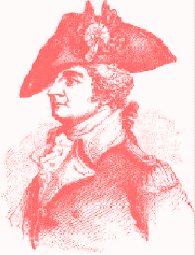
General 'Mad' Anthony
Wayne |
General
Anthony Wayne
The next military general to take on the Miami, Shawnee and other Great Lakes
tribes, was General "Mad" (a term his men used) Anthony Wayne. America’s
military attempt to secure the region had resulted in the construction of many forts,
including: Ft. Greene Ville, 1793; Ft. Recovery 1793 (built on the site of St. Clair’s
massacre); Ft. Piqua, 1795, and Ft.
Loramie in Shelby County, Ohio, 1795. All four forts were built by Wayne.
In 1794, Wayne, with a force of 2,000 well-trained men, 1,000 Kentucky sharpshooters,
and a group of Chickasaw and Choctaw scouts prepared to move north. Before his army left
Fort Washington, a force of 2,500 coalition Indians, led by Little
Turtle, Blue Jacket, and obvious ‘Redcoats",
were beaten and repulsed in an attack on Fort Recovery, June 30, 1794.
Although the Americans suffered an early loss of 50 riflemen outside the stockade, the
fort proved, in two days of battle, to be an impenetrable defense, resulting in the
coalition’s first loss in the war now known as Little Turtle’s War. Following
the defeat, Little Turtle felt it was time to talk peace.
Anthony Wayne Parkway
On November 4, 1947, Oliver Amos, managing editor of the
"Sidney Daily News" was named by Governor Thomas J. Herbert to serve on the
11-man Anthony Wayne Parkway board created by the 97th General Assembly. This board
planned and supervised the development of the Parkway in those counties of Ohio traversed
by the military expeditions of General Anthony Wayne. From Cincinnati, Ohio, to Fort
Wayne, Indiana, signs can be found along State Route 127, State Route 49 and US Route 33.
'Indian' segment written in December, 1997 by David Lodge
[ Back to Indians Index ] |

